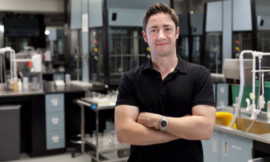
Patrick Gunning has pharmaceutical giants and venture capitalists bidding to develop a molecule he’s invented that will treat cancer.
The 33-year-old associate professor of chemistry from Bute, has a team of 27 working with him at the University of Toronto.
Trials could start on brain cancer sufferers within two years after his breakthrough creation killed brain cancer cells in mice, as well as in extracted human cells.
If successful, it would lead to the drug being used to treat a number of other cancers, such as breast cancer and leukaemia.
Patrick said: “Seeing molecules I’ve made kill cancer cells is hugely rewarding and helped me decide my career should be in cancer research.
“This molecule definitely offers hope. It kills brain cancer stem cells and could lead to its use in treating other cancers.”
But teenage Patrick’s aspirations were much different.
“As a boy, I would play tennis six hours a day,” he continued. “It was really my mum, who is a primary school teacher, who I have to thank for keeping me focused on education.
“I had dreams of playing tennis professionally, but when I took part in a tournament at 16 and met players much better than me, I realised it wouldn’t be a good way for me to make a living!”
Even then, Patrick planned on using his artistic talents for a career in architecture.
“I didn’t fancy seven years at uni, which was the length of the architecture course, so I went for chemistry instead. It’s funny how things work out, because now I’m spending the rest of my career at university!”
Patrick’s artistry did come in handy, though. After graduating from Glasgow University, he secured a place at Yale in the States.
“I paid for my flight by selling paintings I had on display in galleries around the west coast of Scotland,” he smiled.
After two years there, he moved to Toronto, where he came up with the potentially life-saving development.
“I went after a protein in our bodies called Stat3, which becomes hyper activated in cancer patients.
“It leads to cancer progress and tumour formation, and can also become drug resistant, but our molecule blocks its function and makes it easier to kill.
“Stat3 is found in 60% of all human cancers.
“Our molecule has worked in mice models with human lung, brain and breast cancers, as well as two different types of leukaemia.”
Working on such a massive project means Patrick doesn’t have spare time for outside interests.
“I’m a workaholic. I start at 8am and finish around 11pm.
“A lot of my time is spent trying to obtain grants for research. It costs more than $1m a year to run our group.”
Patrick, whose sister is a lecturer and his brother an actuarial analyst, is back home in Bute for a brief visit this weekend to collect the latest in a long line of accolades.
He was the recipient of the Baird of Bute Society Innovation Award on Friday evening.
“It’s an honour to get an award from home,” he added. “I’m in a very rewarding field.”

Enjoy the convenience of having The Sunday Post delivered as a digital ePaper straight to your smartphone, tablet or computer.
Subscribe for only £5.49 a month and enjoy all the benefits of the printed paper as a digital replica.
Subscribe